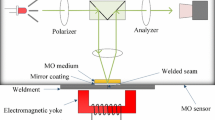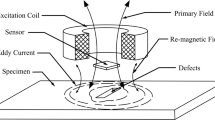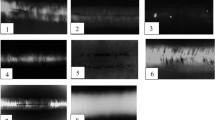Abstract
The weld cracks of the high-strength steel are identified by magneto-optical imaging. The background and basic principle of micro-crack inspection after welding by magneto-optical imaging (MOI) are discussed. The key point is to adopt continuous fuzzy enhancement on the basis of fuzzy set theory, to improve the degree of separation of welding crack and weld and solve the problem of uneven magnetic surface of high-strength steel. The experiment of restoring the magneto-optical image is carried out by using the algorithm of unevenness of crack magneto-optical imaging of high strength steel. After restoration, the PSNR data of magneto-optical image is large, indicating that image quality is greatly improved. According to the characteristics of magneto-optical imaging method, an array crack identification model of laser welding is established by using principal component analysis (PCA) method and support vector machine (SVM). The test results validate that our proposed method can efficiently extract the features of welding cracks and improve the precision of detecting welding cracks.














Similar content being viewed by others
References
Li SC, Chen GY, Zhou C (2015) Effects of welding parameters on weld geometry during high-power laser welding of thick plate. Int J Adv Manuf Technol 79(1–4):177–182
Gao XD, Chen YQ (2014) Detection of micro gap weld using magneto-optical imaging during laser welding. Int J Adv Manuf Technol 73(1–4):23–33
Kumar R, Somkuva V (2015) A review on analysis, monitoring and detection of weld defect products. Int J Eng Technol Res 4:11
You DY, Gao XD, Katayama S (2016) Data-driven based analyzing and modeling of MIMO laser welding process by integration of six advanced sensors. Int J Adv Manuf Technol 82(5–8):1127–1139
Cheng YH, Deng YM, Bai LB, Tian GY (2012) A structural health monitoring method based on magneto-optical imaging technology. IEEE Instrum Meas Technol Con:2221–2224
Gao XD, Zhen RH, Xiao ZL, Katayama S (2015) Modeling for detecting micro-gap weld based on magneto-optical imaging. J Manuf Syst 37:193–200
Gao XD, Liu YH, You DY (2014) Detection of micro-weld joint by magneto-optical imaging. Opt Lasers Technol 62:141–151
Rodil SS, Gómez RA, Bernárdez JM, Rodríguez F, Miguel LJ, Perán JR (2010) Laser welding defects detection in automotive industry based on radiation and spectroscopical measurements. Int J Adv Manuf Technol 49(1–4):133–145
Liu J, Xu GC, Ren L, Qian ZH, Ren LQ (2016) Defect intelligent identification in resistance spot welding ultrasonic detection based on wavelet packet and neural network. Int J Adv Manuf Technol 90(9–12):1–8
Sheng J, Cai Y, Li F, Hua XM (2017) Online detection method of weld penetration based on molten pool morphology and metallic vapor radiation for fiber laser welding. Int J Adv Manuf Technol 92(1–4):231–245
Lin JH, Yao Y, Ma L, Wang YJ (2018) Detection of a casting defect tracked by deep convolution neural network. Int J Adv Manuf Technol 97(4):1–9
Pashagin AI, Shcherbinin VE (2012) Indication of magnetic fields with the use of galvanic currents in magnetic-powder nondestructive testing. Russ J NDT 48(9):528–531
García-Martín J, Gómez-Gil J, Vázquez-Sánchez E (2011) Non-destructive techniques based on eddy current testing. Sensors 11(3):2525–2565
Gao XD, Mo L, Xiao ZL, Chen XH, Katayama S (2016) Seam tracking based on Kalman filtering of micro-gap weld using magneto-optical image. Int J Adv Manuf Technol 83(1–4):21–32
Gao XD, Lan CZ, You DY (2017) Weldment nondestructive testing using magneto-optical imaging induced by alternating magnetic field. J Nondestruct Eval 36(3):55
Funding
This article was partly supported by the National Natural Science Foundation of China (Grant No. 51675104), the Innovation Team Project, Department of Education of Guangdong Province, China (Grant No. 2017KCXTD010), and the Science and Technology Planning Public Project of Guangdong Province, China (Grant No. 2016A010102015).
Author information
Authors and Affiliations
Corresponding author
Additional information
Publisher’s note
Springer Nature remains neutral with regard to jurisdictional claims in published maps and institutional affiliations.
Rights and permissions
About this article
Cite this article
Gao, X., Du, L., Xie, Y. et al. Identification of weld defects using magneto-optical imaging. Int J Adv Manuf Technol 105, 1713–1722 (2019). https://doi.org/10.1007/s00170-019-04401-x
Received:
Accepted:
Published:
Issue Date:
DOI: https://doi.org/10.1007/s00170-019-04401-x




